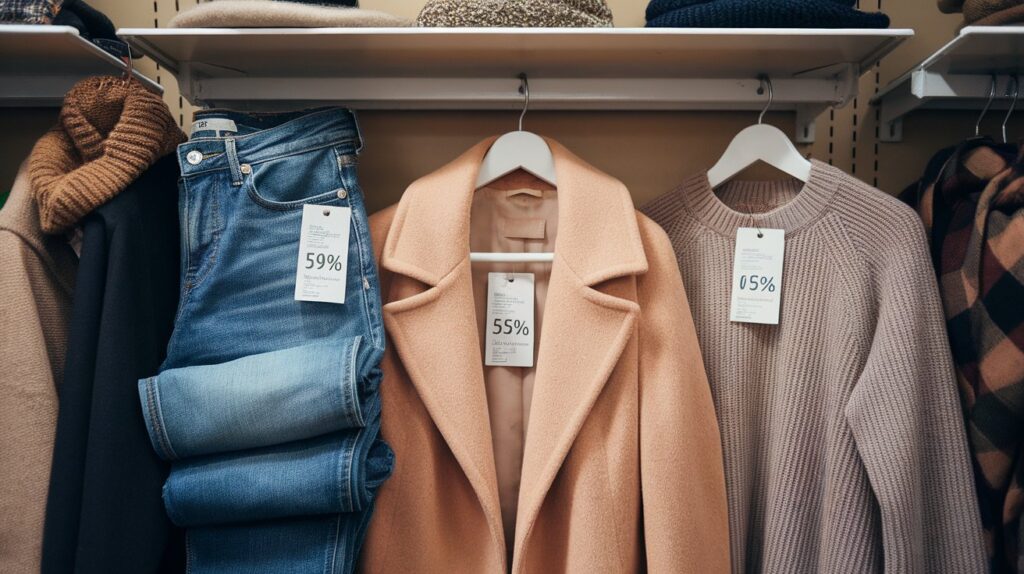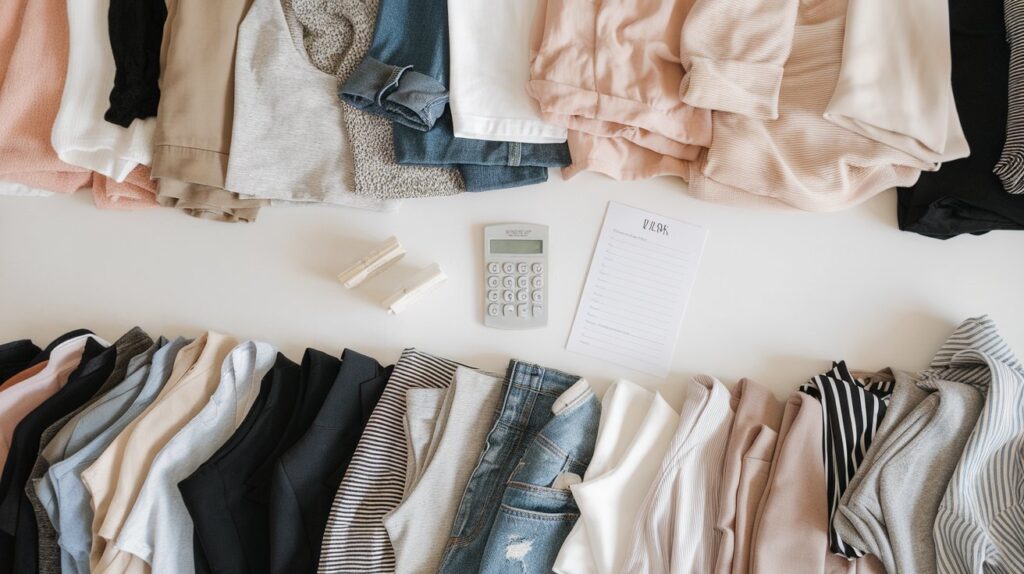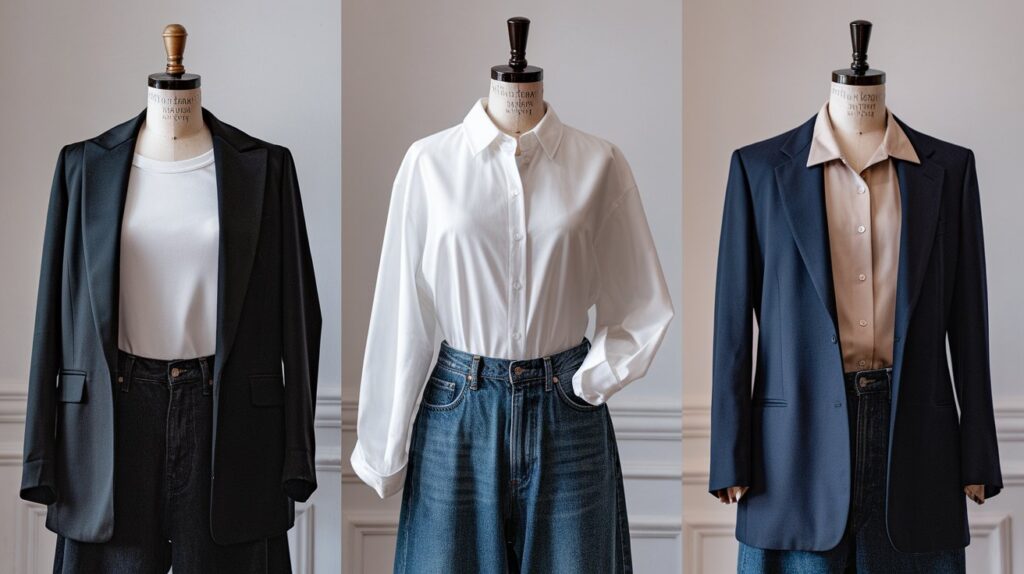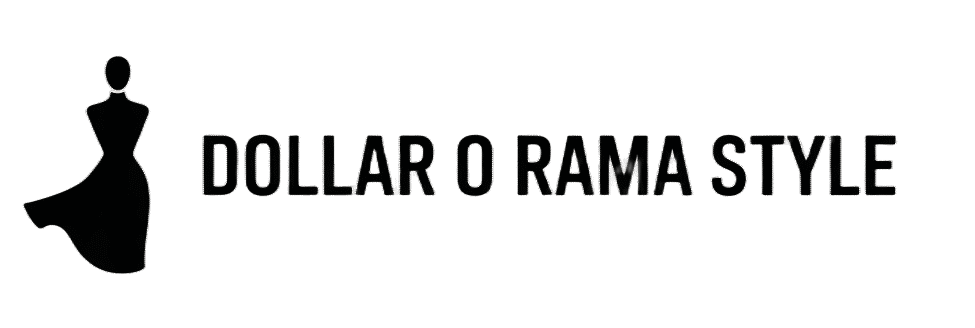How to Build a Capsule Wardrobe on a Budget: 7 Proven Strategies
Building a capsule wardrobe doesn’t require a trust fund or unlimited shopping budget. In fact, some of the most successful capsule wardrobes are built on shoestring budgets by people who understand the true power of strategic shopping and intentional styling.
If you’ve been scrolling through perfectly curated closets featuring designer pieces and wondering how you could ever afford to simplify your wardrobe, this guide is for you. I’m going to show you exactly how to build a functional, stylish capsule wardrobe without draining your bank account—and why doing it on a budget might actually make you better at it.
What Is a Capsule Wardrobe (And Why Budget Matters)
A capsule wardrobe is a curated collection of versatile clothing pieces that work together seamlessly to create multiple outfits. Typically consisting of 25-40 items per season, these pieces are chosen for their ability to mix and match, their timeless appeal, and their alignment with your lifestyle.
The concept was pioneered by London boutique owner Susie Faux in the 1970s and gained mainstream attention when designer Donna Karan released her “Seven Easy Pieces” collection in 1985. Today, capsule wardrobes have resurged in popularity thanks to growing awareness about sustainable fashion and the environmental impact of fast fashion.
Here’s the reality: Building a capsule wardrobe on a budget actually forces you to make smarter, more intentional choices. When every purchase matters, you become an expert at identifying versatile pieces, spotting quality construction, and understanding what truly works for your lifestyle.
The True Benefits of a Budget-Friendly Capsule Wardrobe
Financial Benefits:

- Reduce clothing spending by 40-60% annually
- Lower cost-per-wear on each item
- Eliminate impulse purchases
- Save on dry cleaning and maintenance costs
Research from the Bureau of Labor Statistics shows that the average American household spends approximately $1,700 per year on clothing. By adopting a capsule wardrobe approach, many people reduce this to $600-$800 annually—savings of $900-$1,100 every year.
Lifestyle Benefits:

- Get dressed in under 10 minutes every morning
- Always have something to wear (no more “closet full of clothes, nothing to wear” syndrome)
- Reduce decision fatigue
- Travel lighter with cohesive pieces
Studies published in the Journal of Consumer Psychology show that reducing daily clothing choices can decrease decision fatigue and improve overall mental clarity. When you simplify your wardrobe, you preserve mental energy for more important decisions throughout your day.
Environmental Impact:

- Reduce textile waste significantly
- Support sustainable fashion practices
- Lower your carbon footprint
- Minimize water and chemical pollution from fashion production
According to the United Nations Environment Programme, the fashion industry produces 10% of global carbon emissions and is the second-largest consumer of water supply. By building a capsule wardrobe, you’re directly reducing your contribution to these alarming statistics.
The Budget Reality Check: How Much Does It Actually Cost?
Let me be straight with you: most capsule wardrobe guides gloss over the actual costs. They’ll recommend $200 jeans and $400 coats while telling you to “invest in quality.” But what if your entire clothing budget for the year is $400?
Here’s what building a capsule wardrobe actually costs at different budget levels:
| Budget Level | Starter Budget | Moderate Budget | Comfortable Budget |
|---|---|---|---|
| Total Amount | $200-400 | $500-800 | $1,000-1,500 |
| Timeline | 6-12 months | 3-6 months | 1-3 months |
| Primary Sources | Thrift, sales, swaps | Mix of new/used | New with some premium pieces |
| Number of Pieces | 25-30 | 30-35 | 35-40 |
| Expected Lifespan | 1-2 years (with strategic replacement) | 2-3 years | 3-5+ years |
The good news? You don’t need to buy everything at once. In fact, rushing the process usually leads to expensive mistakes.
Step 1: Audit Your Current Wardrobe (The $0 Foundation)
Before spending a single dollar, you need to understand what you already own. This step alone can save you hundreds of dollars by preventing duplicate purchases and helping you identify what’s actually missing.
The Three-Pile Method
Grab three large bags or designate three areas of your room:
Pile 1: Love & Live In These are pieces you reach for constantly that fit well, feel comfortable, and match your lifestyle. They’re the foundation of your capsule.
Pile 2: Maybe/Needs Repair Items you like but don’t wear often, or pieces that need minor fixes. These are candidates for tailoring or upcycling.
Pile 3: Donate/Sell Anything that doesn’t fit, suit your lifestyle, or bring you joy. These items can fund your capsule through consignment or resale apps.
Calculate Your Current Wardrobe Value
Here’s an exercise most people skip but shouldn’t: monetize your “Donate/Sell” pile. Take clear photos and list items on:
- Poshmark (best for brands like Zara, J.Crew, Madewell)
- ThredUp (convenient but lower payouts)
- eBay (good for unique or vintage pieces)
- Facebook Marketplace (local sales, no shipping)
- Local consignment shops (immediate cash, lower prices)
Realistic expectations: You’ll typically recoup 10-30% of the original retail price, but that can easily translate to $50-200 for your new capsule budget.
Step 2: Define Your Capsule Style & Lifestyle Needs
The biggest mistake people make when building a budget capsule wardrobe is copying someone else’s list. A minimalist blogger working from home needs completely different pieces than a teacher, nurse, or corporate professional.
The Lifestyle Audit Exercise
Answer these questions honestly:
Daily Activities:
- What do I do most days? (office work, physical labor, childcare, creative work)
- How much time do I spend in different settings? (30% office, 50% home, 20% social)
- What physical activities are part of my routine? (gym, yoga, running, hiking)
Climate Considerations:
- What’s my actual weather like 80% of the year?
- Do I have extreme seasonal variations?
- What temperature range do I need to dress for?
Style Preferences:
- What silhouettes make me feel confident?
- Which colors look best on me and work with my skin tone?
- Do I prefer structured or relaxed fits?
- What’s my natural style inclination? (classic, bohemian, edgy, sporty, romantic)
Create Your Personal Color Palette
Here’s a budget-friendly secret: limiting your color palette to 3-4 neutral colors plus 1-2 accent colors makes everything mix and match, which means you need fewer pieces.
Budget-Friendly Color Combinations:
| Base Neutral | Secondary Neutral | Accent 1 | Accent 2 | Why It Works |
|---|---|---|---|---|
| Black | Grey | White | Burgundy | Classic, easy to find second-hand |
| Navy | Cream | Camel | Olive | Sophisticated, forgiving |
| Brown | Beige | Rust | Denim | Warm, vintage-friendly |
| Charcoal | White | Navy | Rose | Modern, professional |
Pro tip: Choose neutrals that complement your skin tone. If you look washed out in black, replace it with navy or charcoal. If bright white isn’t flattering, opt for cream or ivory.
Step 3: The Budget Capsule Formula (What to Actually Buy)
Here’s my proven formula for a 30-piece capsule wardrobe that works across budgets:
The Essential Pieces Breakdown
Tops (10-12 pieces):
- 3 basic tees (white, grey, black or colors that suit you)
- 2 long-sleeve tops (one casual, one polished)
- 2 button-down shirts (one white/light, one patterned)
- 2 sweaters (one lightweight, one chunky)
- 1-2 blouses or nicer tops
- 1 cardigan or blazer
Bottoms (6-8 pieces):
- 2 pairs of jeans (one dark, one medium wash)
- 1 pair of black pants (work-appropriate)
- 1 pair of casual pants (chinos, corduroys, or joggers)
- 1-2 skirts or additional pants
- 1 pair of shorts (seasonal)
Dresses (1-2 pieces):
- 1 versatile dress that can be dressed up or down
- 1 seasonal dress (optional)
Outerwear (3-4 pieces):
- 1 everyday jacket (denim, utility, or blazer)
- 1 warm coat (wool, puffer, or fleece)
- 1 rain jacket or trench
- 1 lightweight layer (cardigan or kimono)
Shoes (5-6 pairs):
- 1 pair of white sneakers
- 1 pair of ankle boots
- 1 pair of comfortable flats
- 1 pair of sandals (seasonal)
- 1 pair of dressier shoes
- 1 pair of athletic shoes (if you exercise)
Accessories (5-8 pieces):
- 2 everyday bags (one tote, one crossbody)
- 2-3 belts
- Scarves, jewelry, and hats as needed
The Cost Breakdown Strategy
Here’s how to allocate your budget for maximum impact:
High-Priority Investment Pieces (40-50% of budget):
- Shoes (they affect comfort and posture)
- Outerwear (worn frequently, highly visible)
- One pair of well-fitting jeans
Medium Investment (30-40% of budget):
- Pants and skirts
- Sweaters
- Structured tops
Budget-Friendly Basics (20-30% of budget):
- Basic tees
- Tank tops
- Simple accessories
Step 4: Smart Shopping Strategies for Every Budget
This is where building a capsule wardrobe on a budget becomes an art form. Here are the strategies that actually work:
The Thrift Shopping Blueprint

Thrifting isn’t just about saving money—it’s about finding unique, high-quality pieces at a fraction of retail prices. According to ThredUp’s 2024 Resale Report, the secondhand market is projected to reach $82 billion by 2026, with more consumers choosing pre-owned fashion for both economic and environmental reasons. But you need a strategy to maximize your thrift shopping success.
Best Items to Thrift:
- Denim (Levi’s, Madewell, AG jeans for $8-20)
- Wool coats and blazers (often unworn, like-new condition)
- Leather goods (belts, bags, boots with years of life left)
- Cashmere sweaters (high-end brands at 5% of retail)
- Dress shirts and blouses (easy to find in excellent condition)
Items to Skip at Thrift Stores:
- Underwear and intimate apparel
- Heavily worn shoes with broken-down soles
- Stretched-out basics (unless under $2)
- Anything with stains, holes, or permanent damage
Thrift Shopping Schedule:
- Monday-Wednesday mornings: Freshly stocked from weekend donations, fewer shoppers
- End of season sales: January (winter) and July (summer) for deepest discounts
- Wealthy neighborhoods: Higher-quality donations, same prices
The Online Shopping Strategy
Best Apps & Sites for Budget Capsule Building:
| Platform | Best For | Price Range | Pro Tips |
|---|---|---|---|
| ThredUp | Convenient, pre-filtered quality | $ | Use “rescue box” for $10 mystery pieces |
| Poshmark | Name brands, negotiable prices | $-$$ | Make offers at 30-50% off listing |
| eBay | Vintage, specific brands | $-$$$ | Use “watch” feature, bid in final minutes |
| Depop/Vinted | Unique pieces, younger sellers | $ | Search by measurements, not size |
| ASOS Outlet | New, discounted trendy pieces | $-$$ | Filter by “% off” and “price low-high” |
| Nordstrom Rack | Designer for less | $$-$$$ | Shop clearance section, sign up for alerts |
| Target/H&M/Uniqlo | New basics | $ | Focus on basics only, avoid trends |
The Sale Shopping Calendar
Knowing when to shop is just as important as where:
January: Winter clearance (70-90% off coats, sweaters, boots) February: Presidents Day sales (20-40% off most retailers) April: Spring clearance before summer stock arrives May: Memorial Day weekend (major sales) July: Summer clearance (swimwear, sandals, shorts) September: Back-to-school sales, Labor Day weekend November: Black Friday (but avoid impulse buying) December: Post-Christmas clearance (December 26-31)
Budget hack: Buy out-of-season. That $150 winter coat in January? It’s $40. Those sandals in September? 70% off.
Step 5: The Quality Assessment Checklist
When you’re shopping on a budget, learning to assess quality quickly is crucial. Here’s what to check:
The 60-Second Quality Test
For Tops & Dresses:
- Hold up to light—can you see through it? If yes (and it’s not sheer by design), pass.
- Check seams—are they straight and finished? Loose threads = poor construction.
- Stretch the fabric—does it bounce back or stay stretched? If it stays, it won’t hold up.
- Examine the hem—is it even and well-finished? This indicates overall quality.
For Jeans & Pants:
- Check the inseam—should be reinforced and flat (not bulky).
- Look at button/zipper quality—metal > plastic, heavy-duty > flimsy.
- Feel the weight—substantial denim lasts longer than thin.
- Test the stretch—should feel substantial, not thin or overly elastic.
For Shoes:
- Bend the sole—it should flex at the ball of the foot, not in the middle.
- Check stitching—should be even and sturdy, especially where upper meets sole.
- Smell them—strong chemical smell = cheap materials that won’t breathe.
- Weight test—quality shoes have some heft; super-light often means cheap.
For Outerwear:
- Check lining—should be attached well, not pulling or loose.
- Test zippers—should glide smoothly without catching.
- Examine buttons—should be sewn securely with reinforcement.
- Assess fabric—wool should feel soft not scratchy; synthetic should feel substantial.
Natural Fiber vs. Synthetic: The Budget Truth
Here’s something most guides won’t tell you: you can buy quality synthetic pieces on a budget. Not all synthetics are bad, and not all natural fibers are good.
Best Budget-Friendly Fabrics:
- Polyester blends (60/40 with cotton): Wrinkle-resistant, durable
- Tencel/Lyocell: Soft, sustainable, drapes beautifully
- Cotton blends: Breathable, easy care, affordable
- Acrylic knits: Warm, wool-like without the price
- Performance fabrics: For athletic wear, incredibly durable
Red Flags (Even If Cheap):
- 100% polyester that feels like plastic
- Acrylic that pills immediately
- Rayon that wrinkles when you breathe on it
- Anything that smells strongly of chemicals
Step 6: Building Your Capsule on Three Different Budgets
Let me show you exactly how to build a complete capsule at three different price points. These are realistic budgets based on strategic shopping.
The $300 Starter Capsule (12-Month Timeline)
Strategy: Start with what you own, add 15-20 new pieces over a year through thrifting and sales.
Month 1-2 ($50): Foundation basics
- 2 basic tees from Uniqlo/Target ($20)
- 1 pair of thrifted jeans ($15)
- 1 thrifted cardigan ($15)
Month 3-4 ($60): Building blocks
- 1 button-down shirt (thrifted or Target) ($15)
- 1 pair of black pants (sales/TJ Maxx) ($25)
- 1 pair of white sneakers (sale) ($20)
Month 5-6 ($70): Layering
- 1 blazer or jacket (thrifted) ($20)
- 2 long-sleeve tops (sales) ($30)
- 1 sweater (thrifted or sale) ($20)
Month 7-8 ($50): Shoes & accessories
- 1 pair of ankle boots (thrifted or sale) ($35)
- 1 crossbody bag (sales) ($15)
Month 9-12 ($70): Finishing touches
- 1 dress (thrifted or sale) ($25)
- 1 coat (end-of-season clearance) ($35)
- Accessories and extras ($10)
Total: $300 | 25-28 pieces
The $600 Balanced Capsule (6-Month Timeline)
Strategy: Mix thrifted statement pieces with new quality basics.
Month 1-2 ($180):
- 3 basic tees ($45)
- 2 pairs of jeans (1 new, 1 thrifted) ($80)
- 2 button-down shirts ($40)
- 1 cardigan ($15 thrifted)
Month 3-4 ($200):
- 2 pairs of pants/skirts ($80)
- 2 sweaters ($60)
- 1 blazer or structured jacket ($60 thrifted)
Month 5-6 ($220):
- 3 pairs of shoes (mix new/thrifted) ($130)
- 1 coat ($60 sale)
- 2 bags and accessories ($30)
Total: $600 | 30-33 pieces
The $1,000 Quality Capsule (3-Month Timeline)
Strategy: Invest in fewer, higher-quality pieces from mid-range brands.
Month 1 ($350):
- 4 quality basics (Everlane, Quince) ($120)
- 2 pairs of premium denim ($120)
- 2 button-downs ($60)
- 1 quality sweater ($50)
Month 2 ($350):
- 2 pairs of pants ($100)
- 2 quality sweaters ($100)
- 1 blazer ($90)
- 1 dress ($60)
Month 3 ($300):
- 3 pairs of quality shoes ($180)
- 1 investment coat ($80)
- Bags and accessories ($40)
Total: $1,000 | 32-35 pieces
Step 7: Maximize Your Wardrobe with Outfit Formulas
Here’s the magic: a 30-piece capsule can create over 100 outfits when you understand outfit formulas. This is how you truly stretch your budget.
The Basic Formula Math
With a well-planned capsule:
- 10 tops × 6 bottoms = 60 outfit combinations
- Add 3 layering pieces = 60 × 3 = 180 combinations
- Add accessories and shoes = Virtually endless
10 Go-To Outfit Formulas
- The Classic: White tee + jeans + blazer + sneakers
- The Polished: Button-down + black pants + loafers + belt
- The Cozy: Sweater + jeans + ankle boots + crossbody
- The Layered: Tank + cardigan + trousers + flats
- The Easy Dress: Dress + denim jacket + sandals
- The Weekend: Long-sleeve tee + casual pants + sneakers
- The Professional: Blouse + skirt + blazer + heels
- The Transitional: Tee + cardigan + jeans + booties
- The Elevated Casual: Nice top + jeans + boots + statement accessory
- The Put-Together: Sweater + trousers + coat + bag
Pro tip: Take photos of outfits you love and save them in a phone album. On busy mornings, just recreate a saved look instead of starting from scratch.
Step 8: Maintenance & Longevity Strategies
Making your budget capsule last is just as important as building it. Here’s how to maximize the life of every piece:
Essential Care Tools (Under $50)
- Sweater stone/fabric shaver ($12-15): Removes pilling, extends sweater life by years
- Shoe trees ($15-25): Maintains shoe shape, prevents creasing
- Steamer ($20-30): Faster than ironing, gentler on fabrics
- Stain removal pen ($5): Immediate treatment prevents permanent stains
- Mesh laundry bags ($8): Protects delicates in the wash
Cost-Per-Wear Calculation
This is the metric that matters most when building on a budget:
Formula: Purchase Price ÷ Number of Wears = Cost Per Wear
Examples:
- $200 coat worn 100 times = $2 per wear
- $30 dress worn 3 times = $10 per wear
The goal: Get cost-per-wear under $1 for most pieces, under $5 for special occasion items.
The Repair vs. Replace Decision Tree
Repair if:
- The item fits perfectly and you love it
- Repair cost is under 30% of replacement cost
- It’s a high-quality piece worth saving
- Common fixes: hemming, simple tailoring, buttons, zippers
Replace if:
- The fabric is worn thin or pilling excessively
- It no longer fits your style or lifestyle
- Repair costs approach or exceed replacement cost
- Multiple issues need fixing
Common Budget Capsule Wardrobe Mistakes (And How to Avoid Them)
Mistake #1: Copying Someone Else’s List
Their lifestyle isn’t yours. A fashion blogger’s white linen pants might be your “worn once and stained immediately” nightmare. Build your capsule.
Mistake #2: Buying Everything at Once
This leads to impulse purchases and pieces that don’t work together. Build gradually, test combinations, refine as you go.
Mistake #3: Prioritizing Trendy Over Timeless
That neon bike short might be cute now, but will it work in your capsule next year? Trends are fun, but they shouldn’t form your foundation.
Mistake #4: Ignoring Fit
A $15 thrifted blazer that fits perfectly beats a $100 sale blazer that’s too big. Fit matters more than brand names.
Mistake #5: Forgetting About Lifestyle
If you work from home, you don’t need five blouses and dress pants. If you’re active, you need quality athletic wear. Match your capsule to your actual life.
Mistake #6: Skipping the Trial Period
Wear new pieces at home first. Check comfort, movement, and how they wash. Keep tags on and test before committing.
Beyond the Basics: Capsule Wardrobe Add-Ons
Once your core capsule is complete, consider these strategic additions:
Seasonal Swap-Ins (5-10 pieces per season)
Don’t build four separate capsules. Instead, keep your core 20-25 pieces year-round and swap seasonal items:
Summer additions: Shorts, sundresses, sandals, tank tops Winter additions: Warm boots, heavy coat, scarves, chunky sweaters
Occasion-Specific Pieces
Keep 3-5 special occasion pieces separate from your capsule:
- One formal dress or suit
- One pair of dressy shoes
- One clutch or evening bag
- Formal accessories
These don’t need to mix with everything—they just need to exist for those rare occasions.
The Environmental & Ethical Dimension

Building a budget capsule wardrobe naturally aligns with sustainable fashion principles:
Your Impact By the Numbers
The Environmental Protection Agency reports that Americans throw away approximately 13 million tons of textiles annually—roughly 85 pounds per person. By building a capsule wardrobe instead of buying 100+ pieces annually, you’re making a significant environmental impact.
By building a 30-piece capsule vs. buying 100+ pieces annually:
- Reduce water usage by ~70% (fashion is the 2nd largest water polluter)
- Lower carbon emissions by ~60%
- Divert 70+ pieces from landfills annually
- Reduce microplastic pollution from synthetic fabrics
Ethical Shopping on a Budget
Fair wage brands under $50:
- Pact: Organic basics, fair trade certified
- Quince: Transparent pricing, ethical factories
- Everlane: Radical transparency, competitive pricing
- Threads 4 Thought: Sustainable, affordable
Remember: Buying less is the most ethical choice, regardless of brand.
Real Success Stories: Budget Capsule Transformations
Case Study 1: Sarah, Teacher, $400 Budget
Before: 150+ piece closet, still felt like she had nothing to wear, spent ~$2,000/year on clothes
After: 32-piece capsule built over 8 months
- Saved: $1,600 annually
- Time saved: 2+ hours per week on outfit decisions
- Outcome: “I feel more confident and stylish with less. My morning routine is completely stress-free now.”
Case Study 2: Marcus, Graphic Designer, $750 Budget
Before: Mostly fast fashion that didn’t last, constant shopping trips
After: 28-piece capsule focused on quality basics
- Saved: $1,200 annually
- Cost-per-wear: Under $2 for most pieces after one year
- Outcome: “I stopped chasing trends and started dressing like myself. The investment paid off in six months.”
Your Action Plan: Next Steps
Ready to start building your budget capsule wardrobe? Here’s your step-by-step action plan:
Week 1: Assessment Phase
- ☐ Complete wardrobe audit (3-pile method)
- ☐ Calculate potential funds from selling unwanted items
- ☐ Identify your lifestyle needs and style preferences
- ☐ Choose your color palette (3-4 neutrals, 1-2 accents)
Week 2: Planning Phase
- ☐ Create your capsule list (use the formula above)
- ☐ Set your total budget and timeline
- ☐ Research best shopping sources in your area
- ☐ Create a shopping list with priority rankings
Week 3: Strategic Shopping Begins
- ☐ Start with highest-priority items
- ☐ Check thrift stores and online resale sites
- ☐ Sign up for sale alerts at favorite retailers
- ☐ Begin selling unwanted items to fund purchases
Weeks 4+: Build & Refine
- ☐ Purchase 2-4 pieces per month (budget-dependent)
- ☐ Test new pieces with existing wardrobe
- ☐ Document outfit combinations
- ☐ Adjust and refine as you go
Frequently Asked Questions
Q: Can I really build a functional capsule wardrobe for under $500? Absolutely. By combining pieces you already own, thrift shopping strategically, and timing purchases during sales, $300-500 can build a complete 25-30 piece capsule. It just takes more time and patience than spending $1,500 all at once.
Q: How long does it take to build a capsule wardrobe on a budget? Realistically, 3-12 months depending on your budget. A $300 budget spread over a year feels manageable and allows you to find the best deals. A $1,000 budget can be completed in 2-3 months.
Q: Should I get rid of everything and start over? No! This is an expensive mistake. Start by identifying pieces you already own that work. Build around them gradually. Only purge items you definitely won’t wear.
Q: What if I gain or lose weight? Buy pieces that fit you now, not your goal size. Consider elastic waists, stretch fabrics, and flowing silhouettes that accommodate fluctuations. As your size stabilizes, replace pieces strategically.
Q: How do I handle work dress codes on a budget? Focus your spending on work pieces first since you wear them most. Thrift stores often have excellent professional clothing in like-new condition because people donate pieces after changing jobs or sizing out of them.
Q: Can I include trendy pieces in my capsule? Yes, but limit them to 10-15% of your wardrobe. Use trendy accent pieces (accessories, one statement top) to keep your capsule feeling current without sacrificing versatility.
Q: What about workout clothes? If you exercise regularly, workout wear needs its own mini-capsule (5-8 pieces). Don’t let it crowd out your regular wardrobe, but don’t neglect it either.
Q: How do I maintain variety on a budget? Focus on accessories! Scarves, jewelry, bags, and belts transform basic outfits without requiring more clothes. Shop these at thrift stores for maximum variety at minimum cost.
Final Thoughts: The Freedom of Less
Building a capsule wardrobe on a budget isn’t about deprivation—it’s about intention. It’s choosing freedom over clutter, quality over quantity, and confidence over trends.
The most successful budget capsule wardrobes aren’t built overnight. They’re built piece by piece, with careful consideration and strategic shopping. They evolve with you, adapting to your changing lifestyle, body, and needs.
Every time you open your closet and immediately know what to wear, you’ll remember why you started this journey. Every time you calculate the cost-per-wear on your favorite thrifted blazer (worn 50 times at $12 = $0.24 per wear), you’ll realize the power of thoughtful choices.
Your capsule wardrobe isn’t about perfection. It’s about building a wardrobe that works for you instead of working against you—a wardrobe that fits your life, your budget, and your authentic self.
Start where you are. Use what you have. Build gradually. And watch as your simplified wardrobe creates space for what really matters in your life.
Wardrobe Budget Calculator
💰 Capsule Wardrobe Budget Calculator
Plan your perfect capsule wardrobe based on your budget, lifestyle, and timeline
Your Custom Capsule Wardrobe Plan
Budget Breakdown by Category
Shopping Timeline
Progress Over 3 Months
Recommended pace: Purchase 8-9 items per month







